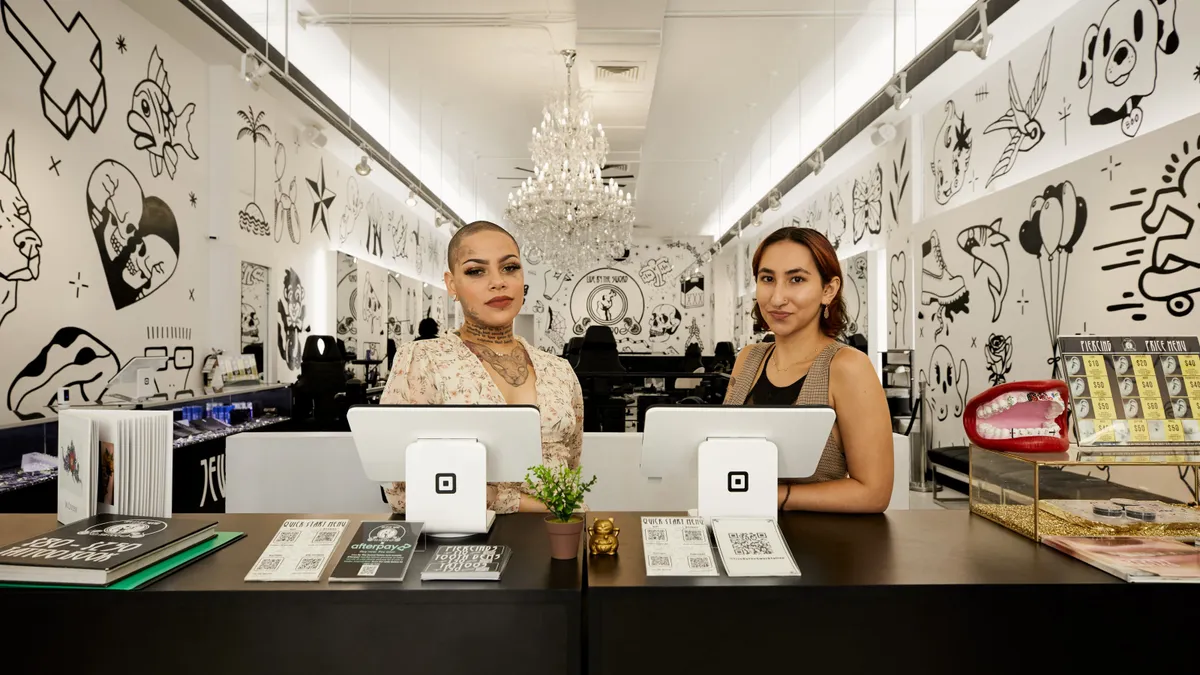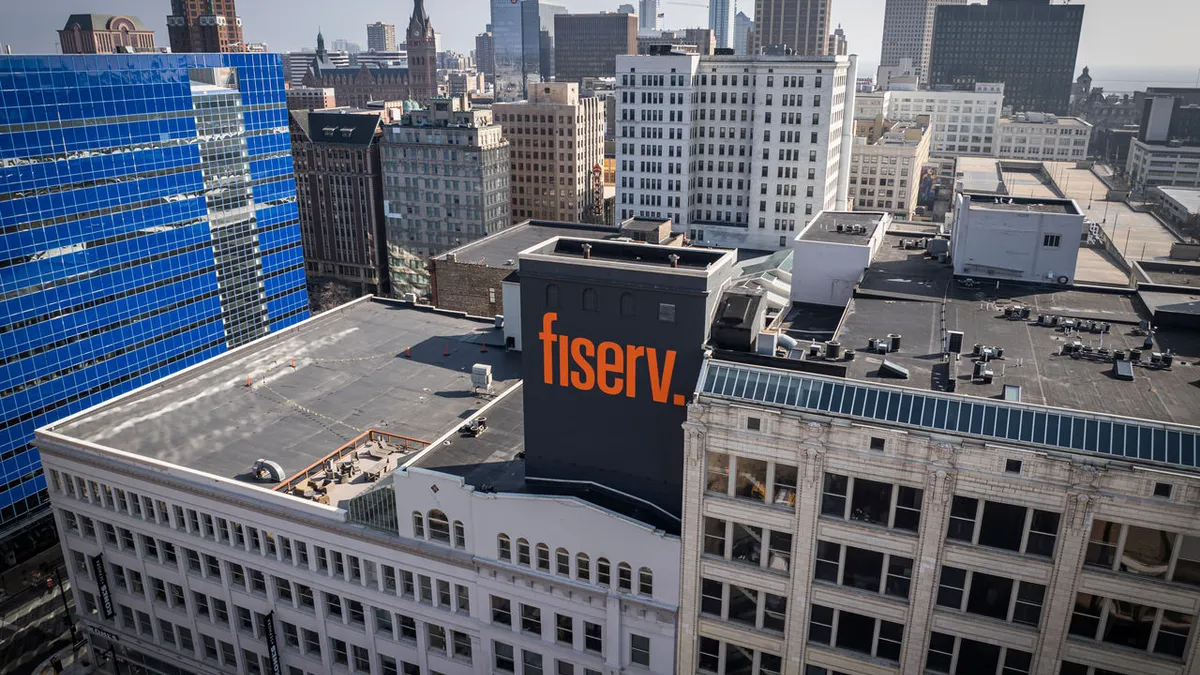Fiserv’s point-of-sale business for small merchants has been growing like a weed. Now, the mega processor is counting on that Clover segment for more growth, expecting the unit to double revenue over the next two years.
Clover is among a crop of industry competitors offering more than just payment acceptance in serving small and medium-sized businesses. Such point-of-sale providers seek to capitalize on the shift to cloud-based software and the surge in entrepreneurship spurred by the COVID-19 pandemic.
Clover has been a boon to payment processing giant Fiserv: Its revenue jumped 30% in the fourth quarter, over the year-earlier period, and the business generated $2.1 billion in revenue last year, largely aided by selling existing merchants more services. Clover’s strength has made it a crucial part of Fiserv’s growth algorithm, said Oppenheimer Analyst Dominick Gabriele.
“Clover just keeps kicking butt,” Gabriele said.
Milwaukee-based Fiserv has set ambitious growth targets for Clover, including planting a flag in international markets and generating revenue of more than $4 billion in 2026, the company shared at its investor day last November.
But in the highly competitive cloud-based point-of-sale market, which Autonomous Research pegs at about $5 trillion, Clover has no shortage of rivals targeting the same retail and restaurant clients. Toast, Shift4, Shopify, Lightspeed Commerce and Block’s merchant unit Square are also gunning to take share from legacy point-of-sale providers such as NCR and Oracle.
Just as Fiserv seeks to rev up Clover’s growth, the head of digital payments company Block, Jack Dorsey, has set his sights on improving Square. A co-founder of Square, Dorsey took the helm of the business last October. “You can’t underestimate Jack Dorsey’s focus,” Gabriele said.
San Francisco-based Square aims to move upmarket, after revamping its sales efforts last year to better keep up with competitors. As Square becomes more competitive, it’s a “significant head-to-head competitor for Clover,” said Bank of America Securities Analyst Jason Kupferberg.
Notably, Clover contrasts itself with Square on at least one promotional webpage geared toward restaurant operators. In catering to restaurants, Clover now has 80% of Toast’s functionality and is targeting 100% by the end of this year, Bank of America Securities analysts wrote in a March 20 note to investors.
Rivals will continue to put pressure on Clover’s goals. To achieve those, analysts and consultants said Clover will need to make headway in other countries and keep signing merchants up for ancillary services it offers, such as inventory management or customer engagement.
For Fiserv, Clover hitting its growth targets is an “absolute must,” said TD Cowen Analyst Bryan Bergin. “The most important metrics coming out of Fiserv are (from) Clover,” he said. “This is kind of the diamond asset in the organization, and you can’t have that roll over.”
Clover spreads
Clover serves about 700,000 businesses with its point-of-sale hardware and software, mainly in restaurant, retail and services verticals, said Dan Bjerke, Fiserv’s global head of Clover. The restaurant vertical is its largest.
About 80% to 85% of Clover’s merchants each process $200,000 to $250,000 in sales annually, he said. Clover was acquired by First Data in 2012 for $56 million, and First Data, in turn, was acquired by Fiserv in 2019 for $22 billion.
Clover’s $272 billion in annualized sales volume tops that of Square and restaurant rival Toast, Mizuho Securities Analyst Dan Dolev noted late last year. With an Android operating system approach, Clover enables merchants to pick and choose apps to help them run their businesses.

“There’s a good value proposition around these modernized platforms, where it’s not just that payment processing capability, it’s the software upsell that comes with it that’s really sticky,” Bergin noted.
That’s given Fiserv confidence to project Clover’s revenue will reach $3.5 billion next year, and $4.5 billion in 2026, according to Fiserv’s November investor conference presentation.
To achieve those targets, Fiserv seeks to add more Clover clients and grow with them. The company has projected the percentage of Clover revenue coming from value-added services — which was in the upper teens each quarter last year — will jump to 27% or more in 2026.
Expanding Clover’s international footprint is crucial to the plan, analysts said. Clover has nascent operations in Argentina, the U.K., Ireland, Germany and the Netherlands. The company expects to bring Clover to Brazil and Mexico this year, and add Australia, Singapore and Hong Kong by 2025.
It’s “been very hard for various players to move overseas with some of these platforms,” Gabriele said. Block has struggled with that, as has PayPal, he added. “If you can do it, it’s a huge deal,” he said.
With international expansion, Fiserv evaluates regions where the Clover brand and value proposition resonate, Bjerke said during a February interview. The processor’s history in other countries gives it an understanding of local nuances, including different payment schemes, competitive dynamics and government regulations and compliance, he said. The company then leans on its local distribution channels in those markets to sell Clover.
Fiserv’s joint ventures or referral programs with some banks; ties with software vendors and independent sales organizations; and direct sales experience allow it “to reach those local businesses in ways that others don't, and I think that's another accelerant of the growth that we've experienced,” Bjerke said.
Clover also aims to expand in verticals where it has a budding presence, such as in government or education, executives have said.
Bjerke declined to comment on the dollar investment Fiserv plans to make in Clover this year. At Fiserv’s investor day, Fiserv CEO Frank Bisignano seemed to needle Block, mentioning Fiserv has 12,000 software engineers alone, whereas Block has capped its entire organization at 12,000 people.
Having more engineers and salespeople will matter, Gabriele said. “This is a scale business, so the more money you can throw at it in a successful way, the better outcome you’re going to have,” he said.
Clover is increasingly important to Fiserv, particularly since growth in the company’s financial technology segment has lagged that of its merchant segment. Clover made up about 25% of Fiserv’s merchant segment revenue last year, but the company expects Clover to drive about 75% of that segment’s growth through 2026, UBS Analyst Tim Chiodo noted in a recent note to investor clients.
Analyst opinions are mixed on whether Fiserv can achieve the growth targets. Autonomous Research Analyst Ken Suchoski said he hasn’t spoken with any investors who believe Clover can reach its revenue goal for 2026.
BofA’s Kupferberg said he wouldn’t call Clover’s ability to meet its targets “a layup,” but ultimately, “I would not put it past Fiserv to be able to achieve these Clover goals,” he said.
Square seeks to simplify
Although Clover tends to serve larger businesses than rival Square, which made its name with micro-merchants, there is overlap between them, especially as Square chases larger clients.
About 60% of Square’s merchant clients generate less than $500,000 in annualized gross payment volume, as of the fourth quarter last year. Of that group, a slightly larger portion generates less than $125,000 in annualized GPV.

As it pushes upmarket, Block’s merchant unit has overhauled its sales approach. Square has mainly connected with customers through its website, but last year, the company verticalized its sales teams and added outbound salespeople. Dorsey has said the business needs to play catchup after falling behind competitors in that regard.
“What Clover has, and offers, that Square doesn’t is a salesforce,” said Ken Musante, founder and president of Napa Payments and Consulting. A Square spokesperson declined to make an executive available for an interview and pointed to comments from the company’s most recent earnings calls.
During Block’s fourth-quarter earnings call last month, Dorsey suggested the company may reconsider Square’s distribution approach. When an analyst asked about willingness to partner with banks or ISOs to get Square’s products into the market, Dorsey said executives are “definitely open” to the idea.
Still, the most important element for Square, Dorsey underscored, is the product itself, which he’s seeking to improve while simplifying the business.
Square’s market share gains have slowed and the business hasn’t identified defined growth targets as Clover has, analysts noted. But Square is under pressure to grow, too. In the near to medium term, Square needs to demonstrate 10% to 15% gross profit growth, Bergin said.
Bjerke largely brushed off the competitive threat Square poses now that Dorsey is again focused on the business, saying Clover doesn’t get “distracted.” He pointed to Clover benefiting from Fiserv’s ownership, which has operating leverage and a balance sheet that allows for investment in the business.
Ultimately, “the market is big, and there's good, competitive solutions out in the market,” Bjerke said.
To that end, despite differences among cloud-based point-of-sale providers and their approaches, there’s room for many to succeed, analysts and consultants said. In the U.S. restaurant industry, for example, UBS analysts estimate some 40% to 50% of locations are still using legacy providers, according to a January note to investors.
When it comes to Clover and Square, “I don’t think it has to be an either or,” Musante said. “My expectation isn't that Clover and Square are stealing as much from each other as the two of them are stealing from Shift4, FIS and Global (Payments).”



















